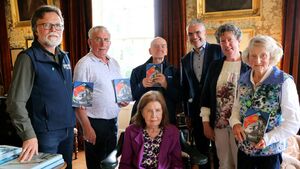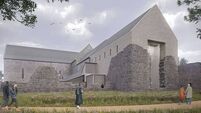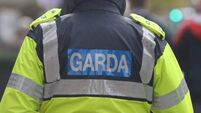Epic Mayo story told for new generation

Attending the launch were Denis Strong (National Parks and Wildlife Service), Uinsíonn Mac Graith, Micheál Ó Seighin, Minister Dara Calleary, Treasa Ní Ghearraigh, Carmel Hughes and Pearl King (seated). Picture: Máire Ní Fhalliún
On July 19th last, in the beautiful setting of Enniscoe House and grounds, Minister Dara Calleary officially launched The Táin Bó Fliodhaise Cattle Raid of Mayo Heritage Trail and Guidebook.
The event brought to fruition the ongoing efforts of a voluntary committee which was set up a number of years ago (under the auspices of Comhar Dún Chaocháin Teo) and whose members currently are Anthony Brogan, Jim Henry, Treasa Ní Ghearraigh, Micheál Ó Seighin, Caitlín Uí Sheighin, PJ Lynn, Uinsíonn Mac Graith, Pat Mc Loughlin and Billy Lyons. The late Niall King and Jim Gilvarry, whose contributions to the project were immense, were fondly remembered on this special occasion.
The aim of the Táin Bó Fliodhaise project steering committee is to highlight and create an awareness of the Mayo Táin or Cattle Raid and bring this epic story to a wider audience. To date, the committee has organised festivals and created links with the community of Argyll in Scotland where the story was written by Medieval scribes in the 15th century. It was first published in the Glenmasan Manuscript, which is held in the Advocates Library in Edinburgh, the National Library of Scotland. This is thought to be a transcript from an earlier 12th century manuscript of the same name. During the early years of the 20th century, the entire story was translated from Gaelic into English by Professor Donald MacKinnon and published over four volumes of a Scottish historical publication known as The Celtic Review.
The Táin Bó Fliodhaise Cattle Raid (a réamhscéal or prequel to the great Irish saga Táin Bó Cuailnge) is an adventurous but little known Celtic mythology saga which takes place in County Mayo, primarily the Erris area in the north-west of the county. It describes how a cattle raid brought Queen Meadhbh and her army from Ráth Chruacháin in County Roscommon on a journey through Mayo to reach their final destination at Rath Muireagáin near Glencastle in Erris. The purpose of the raid was to steal away the prized Maol or hummel cow (which was reputed to supply enough milk daily for 300 men, their wives and children) as well as the herds and wealth of the resident Gamhanraidh tribe. Many of the events in this epic story were driven by power, greed, vengeance, deceit and lust.
The Táin Bó Fliodhaise Cattle Raid of Mayo Heritage Trail consists of 14 site-specific information panels which have been erected at key locations along the route, starting at Cruachán Ai Visitor Centre in Tulsk in Roscommon and continuing on to Ballyhaunis, Aghamore, Bofeenaun, Lahardaun, Enniscoe, Ballina, Moygownagh, Glencalry, Ballinaboy, Munhin Bridge, Rathmorgan, Glencastle, Barr na Trá and Ceathrú Thaidhg. The accompanying guidebook contains a map which shows the sign locations and describes the various events that took place as the story unfolds.
The guidebook is now available in Bookstand (formerly Easons), Pangur Bán Bookshop and Mayo North Tourist Office in Ballina, Castle Bookshop in Castlebar, Westcoast Rare Books and Seamus Duffy’s Bookshop in Westport, Hiney’s in Crossmolina, The North Mayo Heritage Centre in Enniscoe, Leonard’s in Lahardaun, Cruachán Ai Visitor Centre in Tulsk, Carey’s Newsagents in Belmullet and An tSeanscoil in Ceathrú Thaidhg (097 88082 or 087-1251642).
Many agencies and individuals were involved in developing and launching this project including Comhar Dún Chaocháin Teo, Táin Bó Fliodhaise Project Steering Committee, Department of Rural and Community Development, Údarás na Gaeltachta, Mayo County Council, Coillte, Cill Chomáin Rural Social Scheme, National Parks and Wildlife Service, Mayo North, Sláinte Ireland Tours, Cruachán Ai Visitor Centre, Enniscoe House, the artists Will Sliney and Friz and various community members throughout the county, without whom the project could not have been completed. They are all acknowledged in the book.
Following the official launch of the project at Enniscoe House, the large crowd was invited to take a short walk to the information panel which stands on a viewing platform overlooking the National Parks and Wildlife Service’s resident herd of moiled or ‘maol’ cattle. In summing up the project, Minister Calleary stated: “We have an ancient and rich culture in this country and projects like this one help to keep that culture and heritage alive for natives and visitors. This project seeks to preserve the mythology of our people.”





